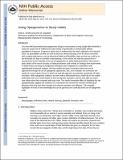Using optogenetics to study habits
Author(s)
Smith, Kyle S.; Graybiel, Ann M.
DownloadGraybiel_Using Optogenetics.pdf (1.355Mb)
PUBLISHER_CC
Publisher with Creative Commons License
Creative Commons Attribution
Terms of use
Metadata
Show full item recordAbstract
It is now well documented that optogenetics brings to neuroscience a long sought-after foothold to study the causal role of millisecond-scale activity of genetically or anatomically defined populations of neurons. Progress is rapid, and, as evidenced by the work collected in this Special Issue, the possibilities of what can now be done are almost dizzying. Even for those concerned with complex phenomena, such as behavioral habits and flexibility, signs are that we could be on the threshold of a leap in scientific understanding. Here. we note this special time in neuroscience by the example of our use of optogenetics to study habitual behavior. We present a basic sketch of the neural circuitry of habitual behavior built mainly on findings from experiments in which lesion and drug microinjection techniques were employed in combination with sophisticated behavioral analysis. We then outline the types of questions that now can be approached through the use of optogenetic approaches, and, as an example, we summarize the results of a recent study of ours in which we took this approach to probe the neural basis of habit formation. With optogenetic methods, we were able to demonstrate that a small site in the medial prefrontal cortex can control habits on-line during their execution, and we were able to control new habits when they competed with prior ones. The nearly immediate effect of disabling this site optogenetically suggests the existence of a mechanism for moment-to-moment monitoring of behaviors that long have been thought to be almost automatic and reflexive. This example highlights the kind of new knowledge that can be gained by the carefully timed use of optogenetic tools.
Date issued
2013-01Department
Massachusetts Institute of Technology. Department of Brain and Cognitive Sciences; McGovern Institute for Brain Research at MITJournal
Brain Research
Publisher
Elsevier
Citation
Smith, Kyle S., and Ann M. Graybiel. “Using Optogenetics to Study Habits.” Brain Research 1511 (May 2013): 102–114.
Version: Author's final manuscript
ISSN
00068993